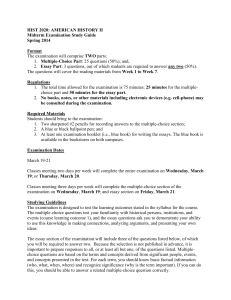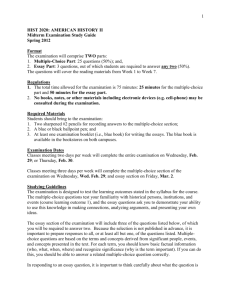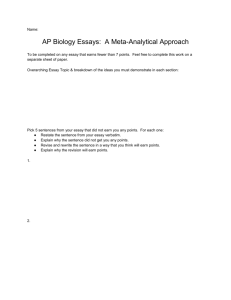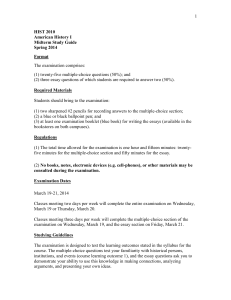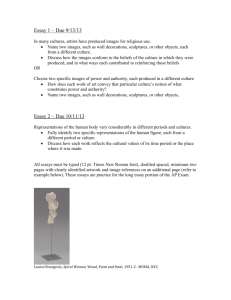American History I - Final Exam Study Guide
advertisement
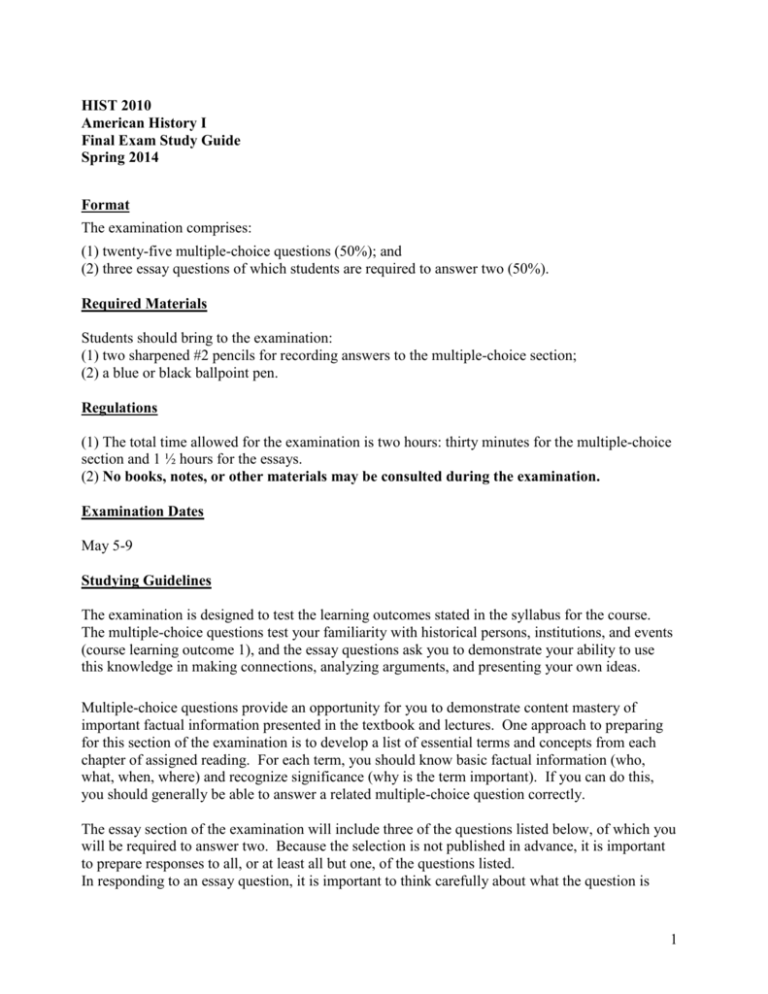
HIST 2010 American History I Final Exam Study Guide Spring 2014 Format The examination comprises: (1) twenty-five multiple-choice questions (50%); and (2) three essay questions of which students are required to answer two (50%). Required Materials Students should bring to the examination: (1) two sharpened #2 pencils for recording answers to the multiple-choice section; (2) a blue or black ballpoint pen. Regulations (1) The total time allowed for the examination is two hours: thirty minutes for the multiple-choice section and 1 ½ hours for the essays. (2) No books, notes, or other materials may be consulted during the examination. Examination Dates May 5-9 Studying Guidelines The examination is designed to test the learning outcomes stated in the syllabus for the course. The multiple-choice questions test your familiarity with historical persons, institutions, and events (course learning outcome 1), and the essay questions ask you to demonstrate your ability to use this knowledge in making connections, analyzing arguments, and presenting your own ideas. Multiple-choice questions provide an opportunity for you to demonstrate content mastery of important factual information presented in the textbook and lectures. One approach to preparing for this section of the examination is to develop a list of essential terms and concepts from each chapter of assigned reading. For each term, you should know basic factual information (who, what, when, where) and recognize significance (why is the term important). If you can do this, you should generally be able to answer a related multiple-choice question correctly. The essay section of the examination will include three of the questions listed below, of which you will be required to answer two. Because the selection is not published in advance, it is important to prepare responses to all, or at least all but one, of the questions listed. In responding to an essay question, it is important to think carefully about what the question is 1 asking and what specific thinking skills you are being asked to demonstrate. Each question tests specific thinking abilities related to learning outcomes #2-5 in the syllabus. The essay questions are not asking you to recite information from lectures or the textbooks. They are asking for your voice, analysis, and judgments. Thorough and accurate information from the course is very important, but a good essay is not just information. It uses information to develop a carefully reasoned response to a specific question and to demonstrate your abilities as an original thinker. The other skill that you are asked to demonstrate in writing your essays is learning outcome #7: the ability to "construct well-written essays using basic academic writing conventions." This means that grammar, spelling, legibility, and organization matter. Your essays should comprise five to eight paragraphs of a reasonable length, including a thoughtful and complete introduction and conclusion. Most students achieve this quality of essay writing only by developing their responses outside of class before actually taking the examination. Although students are not allowed to consult notes or essay drafts during the examination, outlining your responses in detail or even writing complete essays and discussing them with your instructor obviously provides excellent preparation for doing your best on this part of the test. Writing drafts of your essays before the examination also allows you to use this study guide effectively as a resource. Topics 1. The Evolution of Slavery and Industrialization Learning Outcomes: Demonstrate an understanding of regional diversity and the relationship between regions in American history. Analyze the interrelationship of economic, social, cultural, and political change. Analyze changing constructions of race in American history and challenges to racial discrimination. Analyze changing attitudes toward gender in American history and challenges to gender discrimination. Essay Question: Between 1820 and 1860 the United States experienced significant growth and expansion of industry and slavery. What economic and social conditions brought about these simultaneous transformations? In what ways were the lives of slaves and wage laborers impacted and how did they respond to these changes? Considerations: impact of technological developments in transportation, mechanization and education experiences of white women mill workers, urban workers, and Northern free blacks variety of work experiences of enslaved women and men, and urban slaves Southern apologists for slavery methods of resistance to working conditions Readings: Nash 8 & 9; Carson 7&9 2 2. Era of Reform Learning Outcomes: Demonstrate an understanding of regional diversity and the relationship between regions in American history. Analyze the interrelationship of economic, social, cultural, and political change. Analyze changing constructions of race in American history and challenges to racial discrimination. Analyze changing attitudes toward gender in American history and challenges to gender discrimination. Essay Question: The antebellum era was marked by intense social and political change, as Americans undertook many experiments in reform. Trace the origins and development of the major reform movements during this era and analyze their impact on American society. Considerations: origins and development of the women’s rights movement southern efforts to reform slavery goals of and divisions among white and black abolitionists utopian communities, Millerites, and Mormons the role of “Jacksonian democracy” in antebellum reform Readings: Nash 10-12; Carson 7 & 8 3. Manifest Destiny and Territorial Expansion Learning Outcomes: Demonstrate an understanding of regional diversity and the relationship between regions in American history. Demonstrate an understanding of the international context of American history. Essay question: Describe the concept of Manifest Destiny and analyze its impact on the nineteenth-century South and West. How were the ideas of expansionists similar or different from the goals and experiences of ordinary migrants? What effect did the movement of thousands of individuals to the West and Southwest in the 1840s and 1850s have on indigenous peoples? Considerations: the international context for expansionism vis-à-vis Great Britain, Spain, and Mexico motivations and experiences of migrants to Texas, California, Oregon, and Utah population and dynamics of the trails and in western settlement (gender, race, age and expectations of migrants) conflicts with Native American groups analyses of the settlement of Texas and the Mexican-American War Readings: Nash 11-12; Carson 8 3 4. The Impending Crisis: Territorial Expansion and Sectional Conflict Learning Outcomes: Demonstrate an understanding of regional diversity and the relationship between regions in American history. Analyze the interrelationship of economic, social, cultural, and political change. Essay Question: Analyze the major developments between 1848 and 1861 that heightened sectional tensions. Why did the election of Abraham Lincoln spark the secession of the Deep South? Considerations: the role and ultimate failure of compromise as a solution to sectional tensions the development of third-party movements over the issues of slavery and nativism an analysis of lesser and greater “trigger” events of this era northern and southern responses to political disintegration Readings: Nash, 11-12; Carson 8, 9 5. Crucible of Freedom: The American Civil War Learning Outcomes: Demonstrate an understanding of regional diversity and the relationship between regions in American history. Analyze the interrelationship of economic, social, cultural, and political change. Analyze changing constructions of race in American history and challenges to racial discrimination. Essay Question: Discuss the consequences of the Civil War on American society. In your response, be sure to examine the impact of the war on Americans’ daily life as well as in the realm of politics, economics, and diplomacy. Considerations: the impact of the Emancipation Proclamation in the North and the South the role of free and enslaved blacks in the course of the war black and white women’s wartime experiences ordinary individuals’ support for and protests against the war diplomatic maneuvers of the North and South the economic effects of the war in the North and the South Readings: Nash 13; Carson 10 6. Reconstruction: America’s Unfinished Revolution Learning Outcomes: Demonstrate an understanding of regional diversity and the relationship between regions in American history. Analyze the interrelationship of economic, social, cultural, and political change. Analyze the historical development of the American political system, including government, the 4 party system, and agents of political change. Analyze changing constructions of race in American history and challenges to racial discrimination. Analyze changing attitudes toward gender in American history and challenges to gender discrimination. Essay Question: Discuss why Reconstruction might be considered an “unfinished revolution.” What long-term legacies did Reconstruction hold for the South and for the nation? Considerations: the role of presidential versus radical Reconstruction in southern and national politics the significance and impact of the Reconstruction amendments the connections and controversies between black rights and women’s rights an analysis of land and labor issues for blacks in the aftermath of the Civil War the evolution of politics in the South during the Reconstruction era. Readings: Nash 14; Carson 10, 11 5




